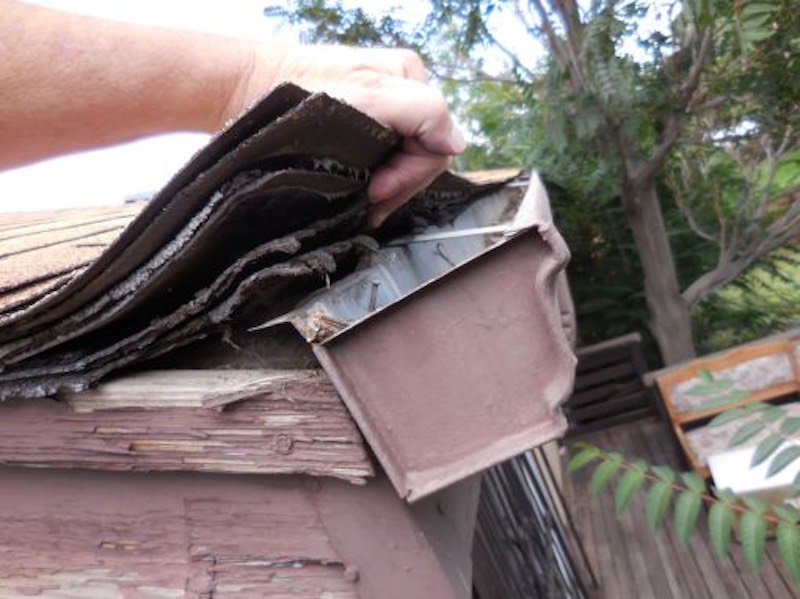Can I Put A Second Layer of Shingles on My Roof
Posted by Corey Zeller Comments Off on Can I Put A Second Layer of Shingles on My Roof Uncategorized
Can I Put A Second Layer of Shingles on My Roof
“Can I put a second layer of shingles on my roof?” You can, but you probably shouldn’t! Known as a layover, putting a second layer of shingles on your roof is in most cases inadvisable and a job that Proven Contracting is likely to even turn down. There are many problems with two layers of shingles that can arise, which why you shouldn’t do spot repairs and should instead replace your roof entirely, but a layover has its own unique set of cons that merit investigation.
The Old Normal
Layovers used to be normal, so it’s not uncommon for older customers to ask, “Why tear off the roof?” But there’s new roofing technology that makes layovers unnecessary, which is good news because it saves you from experiencing all the downsides of a layover. In fact, a layover would actually prevent you from putting in leak barriers and synthetic underlayers.
Not Always Possible
A layover isn’t as simple as just putting on a second layer of shingles. It’s actually more complicated than putting on just a single layer of asphalt shingle! That’s because vallies, intersections, steepness, etc make installation more challenging. These intricacies also make your second layer more vulnerable, which undermines the integrity of your entire roof.
You also have to keep in mind that your roof was designed with a particular weight in mind. Too much stress and pressure on your roof rafter system or framing can lead to roof damage. An average roof has two to three tons of shingles. If you remove all that weight and put on the same weight no harm is done! But a second layer of shingles means doubling that weight at least.
Aesthetically Unappealing
Your second layer of shingles isn’t going to lay flat, and it’s going to lack the same final appearance because it’s a new set of asphalt shingles on top of an old set of shingles. Additionally, your new shingles will be more prone to blow offs.
Not More Waterproof
You may think that adding multiple layers of shingles will make your roof more waterproof but it actually has the opposite effect. That’s because a second layer of shingles will obscure the potential source of a leak as well as keep you from seeing underlying layers such as plywood. Plus, roofing technology has reached a point where enough is done to keep your roof waterproof! And it’s what’s under your roof that helps make your roof waterproof and not what’s under a second layer of shingles.
Hides Signs Of Damage
If you’re considering a layover because you’ve spotted a roof leak, then you’re already past due for roof replacement. If your roof is under 10-years-old then the leak is most likely the result of poor workmanship. If your roof is over 15-years-old then your roof needs to be replaced rather than going the route of spot-repairs or a layover. A second layer of shingles will actually make it harder to identify when you should do a full roof replacement.
Algae and mold, flashing or cement damage, worn or damaged roof shingles, fiberglass granules collecting around your house, and curling, peeling, or blown off shingles are all indicators that it’s time to replace your roof. You won’t be able to see any of that if there’s a layover.
Helps Mold And Algae Grow
A layover will create an environment that improves conditions for algae and mold growth. That’s because the first layer of roofing shingle, if it isn’t already covered in algae and mold, will sponge up water, while the second layer of shingles will seal the water in and provide the darkness that algae and mold needs to grow. Dark streaks running down your roof are signs of algae and mold, but installing a layover will conceal that.
It’s possible, though, that if you put in a second layer of shingles that the mold will get so bad that it’ll pop-through and be able to spot broccoli heads poking out from underneath. If your roof is already covered in mold and algae, however, and you’re insisting on a layover, Proven Contracting will simply turn the job down. It’s not worth it for you or us! The potential harm the layover may cause would reflect too poorly on Proven Contracting for us to accept the work.
When Can You Install A Layover
Layovers as a repair technique are the equivalent of putting a bandaid on a bandaid. It doesn’t look right and it just makes things worse. Even the ideal conditions for a layover aren’t ideal. Your roof would have to be lacking any of the signifies that roof repair is necessary, which would mean that you’d basically have to have a new roof. But a layover is bad for your new roof!
A second layer of shingles will decrease the integrity of your new roof and lower its lifespan. That’s because shingles aren’t designed to have a second layer of shingles on top of them! Plus, all that extra moisture and heat being applied to the first layer of shingles will make that first layer age faster.
How Long It Would Take To Install A Layover
The same factors that influence how long it would take to install a layover are the ones that influence how long it would take to do a full replace.
Pitch: Pitch is a measure of how steep your roof is. The steeper your roof the longer it will take to install your layover because of safety concerns. This would be especially the case with an older roof because the crew would be walking on a damaged shingle. A potential reason a layover wouldn’t be possible!
Complexity: It takes more time to install a new shingle layover on a complex roof. Each part of the roof is known as a facet. The typical A-Frame roof has two facets: one on each side of your home. A complex roof is aesthetically very appealing, and it would be somewhat of a waste to do a layover since the second layer of shingles won’t lay flat, won’t look the same as the first layer, and will be more prone to curling, peeling, and blow offs, all of which will make your roof look less nice.
Flashing: Anyplace that breaks up the contagious nature of roofing material is a place where you’ll find flashing– galvanized steel or aluminum that prevents water damage. If roof protrusions and the areas where the roof meets walls are what inspired the need for flashing, then you can only imagine how much more vulnerable to water damage your roof will be given that a layover will cause more protrusions. After all, you’re literally creating more protrusions and more points of contact between your roof and wall!
Valleys: Valleys, which are any point where two planes meet, increase the amount of time it takes to install a layover just because they demand more care. Again, by creating more points of contact between planes, installing a layover demands even more care than a full replacement.
Why Install A Layover
If it’s basically only a new roof that would accommodate a layover, it begs the question, “Why install a layover?” It doesn’t take that much time or labor to remove the first layer of asphalt roofing shingle that a layover gets your roofing project done faster or cheaper. In fact, a layover would only take longer because there are literally more factors to take into consideration since you have to think about everything you thought about to install your first layer of shingles plus your first layer of shingles.
Flipping A House
If you’re flipping a house and need to cut corners, then a layover might work. Of course, then you’ll be passing the buck on to a roofing contractor to do the repair, which isn’t ethical nor necessarily a good idea since it may earn you a poor reputation. Given that the cost and time of a layover is comparable to a full replace, and the fact that the layover won’t look as good as a full replace, you should just get the full replace.
Saving Money
It’s becoming abundantly clear that a layover isn’t really going to save you money, but saving money is important, especially if you’re wondering, “How do I pay for a roof with no money?” Luckily, there are many ways to pay for a roof when funds are low. You can go with a payment plan; if you have enough equity in your home you can get a loan with a low interest rate; you can get a cash out refinancing, which is when you get a new mortgage on your home with more money than your home requires so that that extra money can be used to pay off debts; and you can reach out to charities, try crowdfunding, or check with your local government.
Bottom Line
At the end of the day, your entire roof is one of the most important investments in your home. Since a second set of shingles undermines the quality of your roof, it’s not the route you should go. A layover is more complicated and the risk just isn’t worth it, so go the route of a full roof replacement. And, preferably, replace your roof before you need to replace your roof to save yourself even more hassle!
Free Roof Estimates
"(required)" indicates required fields

